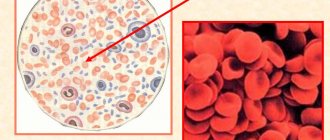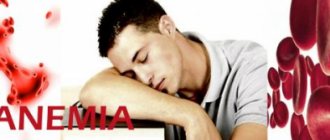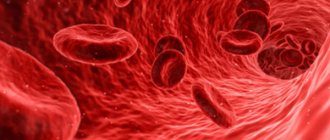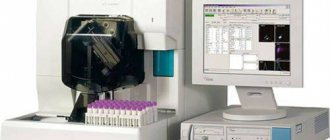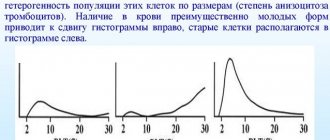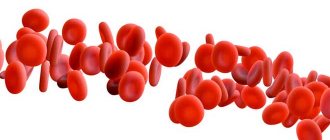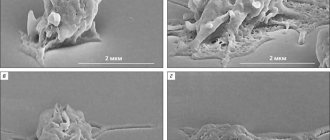RDW (Red cell Distribution Width) or Red cell distribution width is an indicator of the range of changes in red blood cells (erythrocytes) in their sizes. In short, RWD is a measure of how equal in size the red blood cells are in the blood. This indicator may indicate various diseases and disorders in the body. Such diseases include autoimmune and inflammatory problems, liver, kidney and cardiovascular diseases. Below in the article we will explain why increased RDW is bad and how this indicator can be normalized.
The article is based on the findings of 78 scientific studies
The article quotes the authors:
- University of Mississippi, USA
- University of Hawaii, John A. Burns School of Medicine, USA
- Department of Obstetrics and Gynecology, Manisa Merkezefendi Hospital and Manisa Akhisar Public Hospital, Turkey
- Department of Laboratory Medicine, Military Command Area General Hospital, China
- Dipartimento di Scienze Morfologico-Biomediche, Sezione di Chimica Clinica, Italy
- and other authors.
Please note that the numbers in parentheses (1, 2, 3, etc.) are clickable links to peer-reviewed scientific studies. You can follow these links and read the original source of information for the article.
Red blood cells , also called erythrocytes , are the cellular component of blood. Millions of these cells move through the blood vessels and give the blood its characteristic color, carrying oxygen from the lungs to the body's tissues and carbon dioxide, a waste product, back to the lungs for removal from the body.
Typically, red blood cells have a standard size of about 6-8 microns in diameter. They are round, biconvex cells that look like dumbbells in profile. These cells are very flexible and take on a bell shape as they pass through very small blood vessels called capillaries. [] Red blood cells are covered by a membrane made of lipids and proteins, they do not have a nucleus, and they contain hemoglobin (a red, iron-rich protein that binds oxygen).
BLOOD CELLS: platelets, erythrocytes and white blood cells (basophils, neutrophils, eosinophils, monocytes, lymphocytes).
What is RDW
Red blood cell distribution width (RDW) is the change in size (volume) of red blood cells (RBCs). Basically, this test tells you how equal or unequal your red blood cells are in size. The RDW is part of a complete blood count that also measures hemoglobin , hematocrit, and red and white blood cell counts. [, ]
LEFT – ALMOST THE SAME SIZES OF RED CELLS (RDW – NORMAL), RIGHT – SIZES OF RED CELLS VARY GREATLY (RDW – NOT NORMAL)
Low RDW values mean your red blood cells are about the same size, which is normal and desirable. But higher RDW values mean that your red blood cells are produced in different sizes. In other words, there are some problems with the production and survival of red blood cells. [, , ]
value is important , but not specific (not indicating a specific disease) value, therefore the width of the distribution of erythrocytes by volume is used in conjunction with other blood indicators.
Therefore, along with RDW, blood tests also measure such indicators as: MCV (average erythrocyte volume), MCHC (average hemoglobin concentration in an erythrocyte).
Decoding RDW in a blood test: the norm in women and men
There are two types of indicator:
- RDW-CV: reflects the percentage distribution of red blood cells by volume;
- RDW-SD: shows their standard deviation from the norm.
The RDW-CV norm in a clinical (general) blood test is the same for women and men. It is 11–15% and depends on the MCV indicator, changing which may increase the RDW.
The RDW-CV norm in a clinical (general) blood test is the same for women and men. It is 11–15% and depends on the MCV indicator, changing which may increase the RDW. In children, for example in infants, due to the presence of fetal hemoglobin in the blood, physiological anisocytosis is observed, so the RDW indicator may be reduced. And only from 3 months does fetal hemoglobin begin to be replaced by adult hemoglobin.
The interpretation of the RDW-SD blood test shows the heterogeneity of cells in size and volume. This indicator does not depend on MCV and is measured in femtoliters (fl). The RDW-SD norm is 42 ± 5 fl.
If there are a small number of macrocytes and microcytes in the blood, the RDW-SD indicator will be as accurate as possible. The sensitivity of the RDW-CV indicator is slightly lower, but it most accurately reflects overall changes in red blood cell size.
RDW increased: association with diseases
Elevated RDW values may indicate, but do not diagnose or confirm, the following diseases: [, , , ]
- Lack of iron in the body or vitamin deficiency
- Lack of B vitamins, including B12 and folic acid
- Anemia (various types, including sickle cell anemia)
- Inflammation
- Insomnia
- Cardiovascular diseases
- Blood loss due to hemorrhage (including surgery)
- Thalassemia
- Liver disease
- Kidney disease
- Cancer
- Alzheimer's disease
- Alcoholism
- and others.
However, RDW may still be at normal levels in people with leukemia , or with certain types of anemia (such as aplastic anemia ). Therefore, it is important to look not only at the RDW value, but also at the relationship with other markers. []
Normal RDW values
Normal RDW values are the same for men and women. The range of normal RDW in adults is 11.5 – 15.5% , but may vary slightly depending on the reagents used by different laboratories.
In newborn children, normal RDW values are increased to 14.9 – 18.7% due to stress at birth and adjustment to life outside the mother. But as children grow older, their normal RDW values gradually approach those of adults.
At the same time, with age, red blood cells become more varied in size (volume), which leads to an increase in RDW. []
How is it calculated?
The RDW indicator is calculated as a percentage, the norm of which is considered to be the limit from 11.5 to 14.8. The red blood cell distribution index is determined using a mathematical equation that represents the ratio of modified red blood cells to their total mass.
Nowadays, laboratories use computer technologies that make it possible to calculate the percentage of deviation from the established norm. The calculation results are presented in the form of a histogram depicting a curve that indicates probable changes in the dimensions of red blood cells.
RDW reduced
A low RDW value indicates that your red blood cells are uniform in size, which is desirable for health. [] However, it is worth remembering that there is still a possibility of having some kind of disease. []
For example, with reduced RDW values, one may suspect disturbances in the functioning of the spleen, where damaged red blood cells are recycled. In addition, if RDW is low, it is worth thinking about the following possible reasons:
- Recent surgery
- Blood donation
- Severe blood loss (including hidden in the stomach and intestines)
- Hormonal disorders during pregnancy, puberty, and when taking contraceptives
Reasons for the decline
More often it happens that the decoding in the blood test of RDW reveals its increase. But a decrease in the indicator is quite rare. This indicates the presence of quite serious problems in the body. It should be noted that 99.9% of cases of such results occur due to the influence of external factors during the study. This may be inaccurate or incorrect equipment settings, failure or irregularities during storage of the samples under study. If the repeat test also indicates a low RDW, then the reason may be:
- Blood donation.
- A surgical intervention performed to remove an organ or part of it.
- Severe blood loss resulting from pathology or injury. The most dangerous are gastric and uterine bleeding. They cause rapid blood loss, reducing the patient's chances of survival.
- Disruption of metabolic processes in the body, resulting in insufficient absorption of minerals and vitamins from food.
- Hormonal dysfunction. The RDW indicator is often reduced during pregnancy, puberty, and when taking hormonal contraceptives
- Lack of vitamin B or folic acid.
RDW increased
A high RDW means your red blood cells (RBCs) are unequal in size. This condition is called anisocytosis. [, ] This happens when, for some reason, you have trouble producing red blood cells.
Anisocytosis is determined by RDW and is classified according to red blood cell size along with MCV (mean erythrocyte volume):
- Anisocytosis with microcytosis (small red blood cells). Possible causes: iron deficiency, sickle cell anemia.
- Anisocytosis with macrocytosis (large red blood cells). Possible causes: deficiency of vitamin B12 or folic acid, autoimmune hemolytic anemia, cytotoxic chemotherapy, chronic liver disease, myelodysplastic syndrome.
- Anisocytosis with normal erythrocyte sizes. Possible causes: iron deficiency, vitamin B12 or folic acid deficiency, dimorphic anemia, sickle cell anemia, chronic liver disease, myelodysplastic syndrome.
ABNORMAL SHAPE AND SIZE OF RED CYTES
What do the reduced numbers mean?
Patients often ask what this means: “red blood cell distribution index is reduced.” Since the erythrocyte distribution index cannot be assessed without a volume indicator, it is necessary to familiarize yourself with all the options for underestimated indicators and their relationship:
- RDW is low and MCV is below average - indicating problems with the spleen and liver.
- RDW is lowered, and MCV is higher than the normal level - indicates the presence of oncological pathologies, mainly the development of metastases in the bone marrow.
The fact that the erythrocyte distribution index RDW sd is reduced, from a biological point of view, cannot, in principle, be observed. For this reason, most often the patient is offered to donate blood again, observing the following conditions:
- stop smoking and drinking alcohol for 24 hours before blood sampling;
- do not take any medications before the analysis;
- Avoid eating smoked and salty foods the day before.
In the case when the erythrocyte distribution index RDW sd is indeed reduced, which is necessarily confirmed by deviations from the norm in the MCV indicator, then this indicates the occurrence of certain pathologies. These include:
- Hypochromic microcytic anemia - sometimes also called anemia. A condition in which irregularly shaped red blood cells die because they have no biological value in the body.
- Malignant tumors - usually in this case we are talking about mastopathy, bone marrow and lung cancer.
- Hemolysis of red blood cells is a process during which red blood cells die without reaching their target. As a result, active hemoglobin is released.
Reasons for increasing RDW
Nutrient deficiency
Deficiencies of various nutrients can cause an increase in RDW, for example:
- Iron deficiency [, , , ]
- Folic acid deficiency []
- Vitamin B12 deficiency [, ]
This is because your body needs these nutrients to produce healthy red blood cells. Any of these deficiencies can eventually lead to anemia.
Inflammation
Some studies suggest that higher RDW values are associated with inflammation and higher levels of inflammatory cytokines such as IL-6 , IL-8 and TNF-alpha . [, , , , , , ]
Inflammatory cytokines can interfere with red blood cell production and thereby increase RDW. Additionally, oxidative stress , which often accompanies chronic inflammation, can reduce red blood cell lifespan and further increase RDW values. [, ]
High RDW has been found in people with diseases associated with inflammation, such as inflammatory bowel disease , celiac disease, polycystic ovary syndrome (PCOS), and major depressive disorder (MDD). [, , , ]
REASONS FOR INCREASING RDW
Sleep disorders
In a study of 17,500 adults, those who slept less or more than 7-8 hours a night were more likely to have high RDW values. This was especially true for people who slept 10 hours a night - their chances of having increased RDW increased by almost 70%. []
RDW values are higher in people with sleep apnea . [, ]
RDW rates were also associated with shift work with circadian rhythm . In a study of 7,000 women, those who worked shift shifts were almost 50% more likely to experience an increase in RDW compared to women who worked day shifts. []
Bleeding
Severe and moderate injuries with heavy bleeding increase RDW. [] Bleeding may not be visible, as is the case with intestinal and gastric bleeding. [, ]
Blood transfusion
If a person undergoes multiple blood transfusions, their RDW may increase due to differences in blood composition between the donor and recipient. [, ]
Liver disease
Increases in RDW occur in a variety of liver diseases, including hepatitis, alcoholic cirrhosis, biliary cirrhosis, and liver cancer. []
An observational study of 423 adults with liver disease found that their RDW was significantly higher than that of healthy controls. []
In another study of 446 hepatitis B patients, increasing RDW levels corresponded with increased liver size (hepatomegaly) and increased inflammation. []
Kidney disease
One of the kidney hormones, erythropoietin, is needed for the maturation of blood cells. Problems with the production of this hormone occur with kidney disease, leading to the development of RDW. [] People with reduced kidney function have higher levels of RDW. []
Alcoholism
Alcoholics can exhibit high RDW values without liver disease. This is because alcohol can have a toxic effect on red blood cells. []
Thalassemia
Thalassemia may cause increased RDW values. However, patients with thalassemia may also demonstrate normal RDW levels. [, , ]
Sickle cell anemia and hereditary spherocytosis
Sickle cell anemia is an inherited disease. People with this disease have higher RDW values because many of their red blood cells are misshapen. []
Hereditary spherocytosis (Minkowski-Choffard disease), another disease in which red blood cells become misshapen, also causes increased RDW levels. [, ]
DISEASES IN WHICH RDW LEVELS INCREASE (https://medcraveonline.com)
Cancer
RDW rates are often higher in various types of cancer, including stomach cancer , liver cancer , colon cancer , and kidney cancer . [, , , ]
There are many factors in cancer that can interfere with the normal production of blood cells, including chronic inflammation and poor nutrition.
In cancer, RDW often increases with disease severity and metastasis . []
In a study of 25,000 people, the risk of cancer was 30% higher in those people who showed the highest RDW values compared to people with the lowest values. Postmenopausal women with the highest RDW values had a 22% increased risk of developing cancer. But no association was found between RDW values and cancer in premenopausal women. []
Cardiovascular diseases
According to a meta-analysis, an increase in RDW levels accompanies various cardiovascular diseases: acute coronary syndrome (including myocardial infarction ), coronary heart disease , peripheral arterial disease, arterial hypertension , as well as atrial fibrillation . Higher RDW values predict more negative outcomes for these diseases. []
Increased RDW has been associated with various types of cardiovascular disease in studies. [, , ]
In a study of 25,500 adults, each 1% increase in RDW resulted in a 13% increase in heart attack risk . Those people who showed low RDW values had a 71% reduced risk of having a heart attack (myocardial infarction) compared to people with the highest RDW levels. []
Elevated levels of RDW are associated with a high risk of cholesterol plaque building up in the arteries ( atherosclerosis ) in patients with hypertension . []
RWD is associated with autoimmune diseases
There is an association between high RDW levels and increased disease activity in autoimmune problems such as rheumatoid arthritis , lupus, psoriasis, Crohn's disease , Sjögren's syndrome, systemic scleroderma, ankylosing spondylitis ( ankylosing spondylitis ). [, , , , , , ]
INCREASING RDW WITH INCREASING CROHN'S DISEASE/ULCERATIVE COLITIS ACTIVITY (https://www.wjgnet.com)
RWD and metabolic syndrome
People with higher levels of RDW show more advanced degrees of metabolic syndrome. This was found in studies involving more than 217,000 people. [, ]
RWD and diabetes risk
In a study that monitored more than 2,600 people with normal blood glucose levels over 4 years, high RDW values increased the risk of developing diabetes compared to people with low RDW. []
RWD and risk of dementia (dementia)
In a study of approximately 2,500 older adults, higher RDW values had an increased risk of dementia. This risk was significant in those people who were not anemic. []
RWD is associated with mortality
High RDW values increase inflammation and oxidative stress, which contribute to the risk of mortality. In various studies, adult (45+) hospital patients with elevated RDW levels demonstrated a higher risk of cardiovascular mortality, infection, and all-cause mortality . [, , ]
Additionally, in a review of 13 studies (involving 10,410 patients), low RDW was associated with a lower risk of mortality. []
RDW and depression
The study, which followed 43,226 patients with depression for 5.3 years, measured RDW values at the time of diagnosis and in subsequent contacts with doctors. It was found that patients with cardiovascular disease had more advanced depressive syndromes with increasing RDW . []
Decoding
Anisocytosis of red blood cells is determined by a hematology analyzer, which produces a histogram plotting the number of RBCs of different volumes in the sample.
Important information: What does it mean to have an increased average volume of red blood cells in the blood of an adult?
If the analysis is carried out manually, the value of the red blood cell coefficients of variation is calculated from the histogram curve and formula. Manual calculation of parameters is rarely used, because does not provide the necessary accuracy of the result.
A positive test result is when the rate of erythrocyte anisocytosis exceeds the norm. If the result is within the normal range, the test will be negative.
The RDW designation characterizes the heterogeneity of red blood cells:
- RDW-CV in a blood test is a relative value measured as a percentage (%);
- RDW-SD is an absolute parameter measured in volume units of femtoliters (fl) or µm3.
Comparison of the scatter of RBC volumes in the sample is carried out with normal values of 80-100 fl.
Relative index is a value that reflects the distribution of red blood cells, showing by what percentage the red blood cell volumes differ from the average volume.
The value of the absolute indicator indicates how many femtoliters the volumes of red blood cells differ. The calculation is done according to the histogram graph.
The level of relative anisocytosis depends on the value of the MCV parameter (mean blood cell volume). The calculated value of the relative indicator of erythrocyte anisocytosis is obtained by multiplying 100% by the ratio of the standard coefficient to MCV.
The RDW-SD parameter in a blood test allows you to determine how many femtoliters the smallest and largest red blood cells differ from medium-sized red cells.
Normal values
The values of the distribution width of erythrocytes according to norms do not depend on gender. They are the same for an adult of any gender. With age, normal coefficient values do not change.
If heterogeneity does not exceed the norm, it means that the red blood cells are approximately the same size. The norm for absolute anisocytosis in adults is 37-47 fl.
Normal RDW levels for women and men are 11.5%-14.5%.
In women during pregnancy, the normal value of the parameter changes by trimester (%):
- first trimester - 11.7-14.9;
- second trimester - 12.3-14.7;
- third trimester - 11.4-16.6.
In children, the normal level varies. The first 6 months after birth, RDW values are higher than the adult norm. Gradually they decrease.
RDW standards for children (%):
- up to 6 months - 14.9-18.7;
- after six months - 11.6-14.8.
The result of the calculation of relative anisocytosis, which the patient receives in the analysis, is often elevated or normal. A decreased RDW-CV most likely indicates an error.
If the anisocytosis of red blood cells is slightly higher than normal, most often the deviation is random. This value becomes clinically significant for diagnosis when it exceeds 60 fl.
Important information: What does it mean to have a hematocrit reduced or below normal in the blood of an adult and what does the indicator mean?
A decrease in the absolute coefficient of anisocytosis has no significance for diagnosis.
Increased level
Red blood cells are heterogeneous in size and hemoglobin saturation. If anisocytosis is higher than normal, it means that there are blood cells in the bloodstream that are different in volume from the normal range.
Normally, each cell goes through a life course, during which its volume changes. Cells of different sizes are simultaneously present in the blood:
- microcytes, characterized by their small sizes, not exceeding 6 microns;
- normocytes corresponding to normal sizes, in the range of 6-8 microns;
- macrocytes, characterized by large sizes exceeding 8 microns;
- megalocytes, with a diameter > 12 microns.
Normal human RBCs fall within the normocyte range on average. An increased value of heterogeneity is possible with the appearance of microcytes and megalocytes.
The heterogeneity of erythrocytes is characterized by the degree of anisocytosis:
- The first degree corresponds to 27-50% of defective cells.
- Anisocytosis of the second degree is characterized by 55-70% of modified blood cells.
- The third degree of anisocytosis is characterized by the presence of more than 75% of such cells. Their sizes deviate from the norm.
- With the fourth degree of anisocytosis, all 100% of the cells are defective.
If the relative width of the distribution of red blood cells by volume is increased, it means that more than 50% of the cells deviate from the norm.
Relative coefficients of erythrocyte heterogeneity may increase when:
- leukocytosis with a sharp increase in the number of leukocytes;
- lack of nutrients necessary for hematopoietic processes (iron, B vitamins);
- microcytic anemia;
- myelodysplastic syndrome;
- hemolytic crisis;
- malignant tumors that metastasize to the bone marrow;
- RBC agglutination;
- poisoning with heavy metals (lead);
- Alzheimer's disease.
The anisotropy coefficient of erythrocytes increases in vascular diseases. Increased RDW in intoxication caused by alcohol abuse.
If the blood was tested after surgery, severe bleeding, heterogeneity above normal may also be noted. In such a situation, the result exceeds the acceptable standard deviations as a result of the increased production of juvenile cell species.
RDW is elevated in iron deficiency anemia, which is common in pregnant women. The RDW indicator for this disease exceeds 14%.
With vitamin B12 deficiency, macrocytes and megalocytes are found in the bloodstream.
If the anisocytosis index reaches 27%, this means that RDW in a blood test may suggest B12 deficiency anemia.
Important information: What are neutrophils in a blood test in women and a table of norms by age
The width of the distribution of red blood cells is increased during processes accompanied by increased destruction of red blood cells. The death of blood cells is caused by:
- increased bilirubin levels;
- an increase in the size of the liver and spleen;
- accumulation of iron ions in the body.
An increase of up to 40% is possible with thalassemia or Cooley's anemia. This disease is hereditary. Cooley's anemia is most widespread in areas affected by malaria.
Increased values correspond to changes in other erythrocyte parameters. It is necessary to take into account the MCV parameter when interpreting analyses. Simultaneous changes in parameters are observed in cases where:
- the RDW indicator is exceeded, the MCV is reduced (with iron deficiency anemia);
- above normal MCV and RWD (may mean liver pathologies, megaloblastic, hemolytic anemia, cold agglutination);
- there is an excess of the RDW norm in combination with the MCV norm (indicates the likelihood of myelofibrosis).
Reduced index
A reduced RDW in the analysis means that in the sample taken for the study, the cells have practically no difference in volume. Cases where the analysis reveals that all RBCs are the same size are most likely in error.
Red blood cells may be of equal size in anemia, leading to an increased number of defective forms in the bloodstream.
The values of erythrocyte distribution indices decrease with:
- anemia (iron deficiency, folate deficiency, B12 deficiency);
- pregnancy (with the appearance of fetal hemoglobin);
- extensive blood loss (trauma, internal bleeding, childbirth).
Ways to reduce RWD
First of all, it is necessary to treat the underlying disease - the cause of increased RDW values. Below are additional options that can help you improve your health and reduce your RDW.
Balanced diet
Eating a healthy and balanced diet helps prevent nutritional deficiencies. It is especially important that the diet contains the recommended amounts of iron, folic acid and vitamin B12. [, , ] Correcting nutritional deficiencies can improve blood cell production and lower RDW values.
Reduce alcohol consumption
Reducing alcohol consumption may help reduce damage to red blood cells. [, ] Additionally, alcohol also reduces the absorption of nutrients such as vitamin B12 and folic acid, which are essential for the production of red blood cells. [, ]
More physical activity
People who do little or no physical activity show higher levels of RDW. [, ]
Exercise, including light intensity exercise, has been shown in research to improve RDW scores. [, , ]
In a study of more than 8,000 people, as the amount of exercise time per week increased, the risk of showing increased levels of RDW decreased by 11%. []
Quit smoking
Smoking increases oxidative stress. Higher RDWs are identified in smokers and are associated with the number of cigarettes smoked per day as well as the duration of smoking. []
Getting enough sleep
In a study of 17,500 adults, those who slept 7-8 hours had the lowest RDW values. People who slept less than 6 hours, about 10 hours, and more than 10 hours showed increases in RDW of 23%, 29%, and 67%, respectively. []
The information on this site has not been evaluated by any medical organization. We do not seek to diagnose or treat any disease. The information on the site is provided for educational purposes only. You should consult your physician before acting on information from this site, especially if you are pregnant, nursing, taking medications, or have any medical condition.
Rate this article
Average 4.5 Total votes (17)
